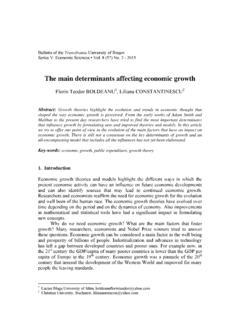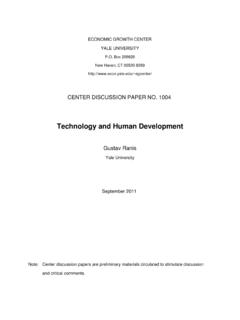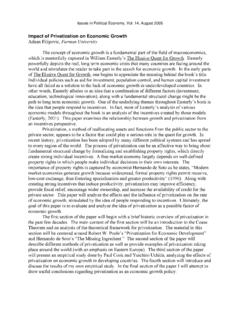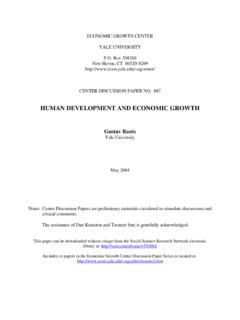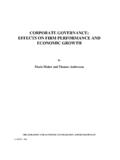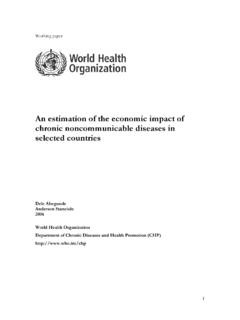Transcription of The effect of foreign aid on economic growth in developing ...
1 Journal of International Business and Cultural Studies foreign Aid and growth , Page 1 The effect of foreign aid on economic growth in developing countries E. M. Ekanayake Bethune-Cookman University Dasha Chatrna University of Florida Abstract This paper analyzes the effects of foreign aid on the economic growth of developing countries . The study uses annual data on a group of 85 developing countries covering Asia, Africa, and Latin America and the Caribbean for the period 1980-2007. The hypothesis that foreign aid can promote growth in developing countries was explored. This hypothesis was tested using panel data series for foreign aid, while accounting for regional differences in Asian, African, Latin American, and the Caribbean countries as well as the differences in income levels. While the findings of previous studies are generally mixed, the results of this study also indicate that foreign aid has mixed effects on economic growth in developing countries .
2 Keywords: foreign aid, economic growth , developing countries . Journal of International Business and Cultural Studies foreign Aid and growth , Page 2 Introduction The role of foreign aid in the growth process of developing countries has been a topic of intense debate. foreign aid is an important topic given its implications for poverty reduction in developing countries . Previous empirical studies on foreign aid and economic growth generate mixed results. For example, Papanek (1973), Dowling and Hiemenz (1982), Gupta and Islam (1983), Hansen and Tarp (2000), Burnside and Dollar (2000), Gomanee, et al. (2003), Dalgaard et al. (2004), and Karras (2006), find evidence for positive impact of foreign aid on growth ; Burnside and Dollar (2000) and Brautigam and Knack (2004) find evidence for negative impact of foreign aid and growth , while Mosley (1980), Mosley, et al.
3 (1987), Boone (1996), and Jensen and Paldam (2003) find evidence to suggest that aid has no impact on growth . It should be noted that, although Burnside and Dollar (2000) concluded that foreign aid has positive effects, this conclusion applies only to economies in which it is combined with good fiscal, monetary, and trade policies. A recent study by Doucouliagos and Paldam (2009), using the meta-analysis covering 68 papers containing a total of 543 direct estimates, it is found that the effect of aid on growth estimates scatter considerably and add up to a small positive, but insignificant, effect on growth . The zero correlation result has yet to be overcome. The main role of foreign aid in stimulating economic growth is to supplement domestic sources of finance such as savings, thus increasing the amount of investment and capital stock.
4 As Morrissey (2001) points out, there are a number of mechanisms through which aid can contribute to economic growth , including (a) aid increases investment, in physical and human capital; (b) aid increases the capacity to import capital goods or technology; (c) aid does not have indirect effects that reduce investment or savings rates; and aid is associated with technology transfer that increases the productivity of capital and promotes endogenous technical change. According to McGillivray, et al. (2006), four main alternative views on the effectiveness of aid have been suggested, namely, (a) aid has decreasing returns, (b) aid effectiveness is influenced by external and climatic conditions, (c) aid effectiveness is influenced by political conditions, and (d) aid effectiveness depends on institutional quality.
5 It is interesting to note that in recent years there has been a significant increase in aid flows to developing countries although other types of flows such as foreign direct investment and other private flows are declining. For example, according to the Organization for economic Corporation and Development (OECD, 2009b), foreign direct investment and other private flows are on the decline, and remittances are expected to drop significantly in 2009. Budgets of many developing countries were hit hard by the rises in food and oil prices in the last two years. Many countries are not in a strong fiscal position to address the current financial crisis. According to the OECD (2009b), in 2008, total net official development assistance (ODA) from members of the OECD s Development Assistance Committee (DAC) rose by in real terms to US$ billion and is expected to rise to US$130 billion by 2010.
6 Africa is the largest recipient of foreign aid (see Table 1). For example, net bilateral ODA from DAC donors to Africa in 2008 totaled US$26 billion, of which US$ billion went to sub-Saharan Africa. Excluding volatile debt relief grants, bilateral aid to Africa and sub-Saharan Africa rose by and 10% respectively in real terms. Journal of International Business and Cultural Studies foreign Aid and growth , Page 3 Given the importance of foreign aid to the economies of developing countries , it is important to understand its contribution to economic growth of developing countries . Therefore, this paper analyzes the effects of foreign aid on the economic growth of developing countries . These effects are analyzed using panel data series for foreign aid, while accounting for regional differences in Asian, African, Latin American, and the Caribbean countries as well as the differences in income levels.
7 One of the contributions of this paper is its input to the existing empirical literature on the effects of foreign aid on economic growth of developing countries through its thorough analysis covering a large number of developing countries as well as a longer time period. The study focuses on the time period 1980-2007. In order to better understand the effect of aid on growth as well as any change of its effect over time, three separate models for shorter time periods, namely, 1980-1989, 1990-1999, and 2000-2007 were also estimated. Even though it is the 21st century, many developing countries still face the issue of serious resource problems. A large portion of these countries are in the ongoing battle with severe debts and strictly dependent on their financial aid inflows. Sadly, the burden placed on these countries by debt servicing is too often overwhelming.
8 Moreover, official development assistance (ODA) flows have fallen over the past decade, and developing countries need to search for alternative ways to become more effective with the utilization of aid inflows via the right policies and seek innovative methods to attract additional aid. Due to the importance of this topic, the impact of foreign aid has been the subject of very extensive investigation. The key question that both the donor and the recipient countries question is whether aid has any effect on developing countries growth and their level of poverty. This issue has been approached from various perspectives; nevertheless, a single and definite answer Table 1. Major Recipients of foreign Aid, 1986-20071986-19871996-19972006-2007 Total ODA US$ Million41,093 $ 59,534 $ 116,413 $ Distribution of foreign Aid by Country Group (%)Country Group1986-19871996-19972006-2007 developing Low-Income of foreign Aid by Region (%)Region1986-19871996-19972006-2007 Sub-Saharan and Central Asia and East and North America and : Organization for economic Corporation and Development (OECD).
9 Journal of International Business and Cultural Studies foreign Aid and growth , Page 4 still does not exist. Therefore, it is important to note that not only factors such as the amount and type of financial aid impact the effectiveness of available funds but also the appropriate use of these funds by the receiving country plays a vital role. The paper is structured as follows: The next section presents a survey of literature, whereas Section 3 presents the specification of the econometric model and data sources. The empirical results are presented and discussed in Section 4 and finally, Section 5 summarizes the main results and concludes with some policy implications. Literature Review The relationship between foreign aid and economic growth has drawn great attention for years, but the empirical results are mixed.
10 There is now a large literature on the relationship between aid and growth . For a recent comprehensive survey of the theoretical and empirical literature on foreign aid and growth see Hudson (2004) and McGillivray, et al. (2006). A study conducted by McGillivray (2005) demonstrates how aid to African countries not only increases growth but also reduces poverty. Furthermore, the author points out the important fact that continuously growing poverty, mainly in sub-Saharan African countries , compromises the MDGs (Millennium Development Goals) main target of dropping the percentage of people living in extreme poverty to half the 1990 level by 2015. His research econometrically analyzes empirical, time series data for 1968-1999. The paper concludes that the policy regimes of each country, such as inflation and trade openness, influence the amounts of aid received.










